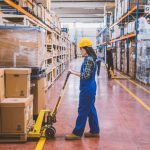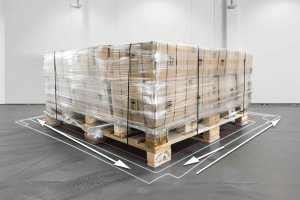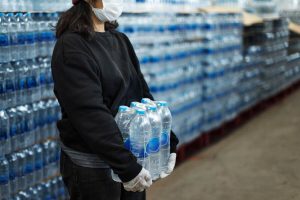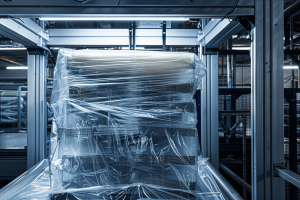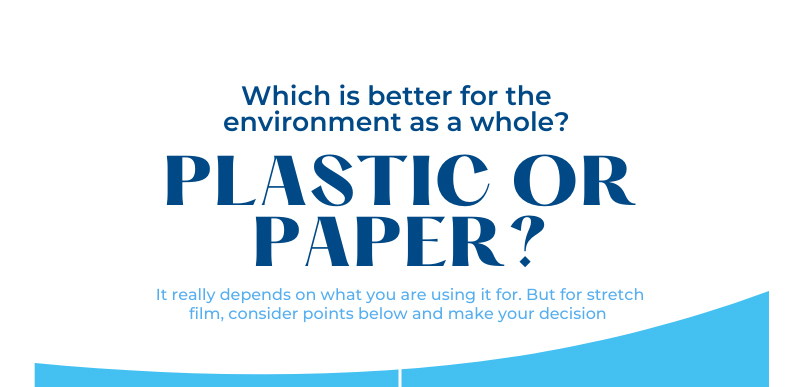
Recycling plastics vs papers has always been a heated discussion among industries but necessary with great exigence.
We often hear this among consumers, paper or plastic?
Convinced that they are making a better choice for the environment—some insisted on paper, while others on plastics.
Of course, if there is a choice, purely for environmental sake, neither would be the better answer.
However, plastic packaging is inevitable.
We have discussed how invaluable plastics are during our #LiveGreen Launch comprehensively.
Therefore, can you imagine a world without paper or plastic packaging?
Therefore, the reality for industries and businesses is not as straightforward.
The environmental factor is not the only decision businesses make on packaging materials.
It’s tough. Weighing between costs and profits or bottom line and environment is a tough spot to be in.
Most growing businesses will be in a tough spot to aim for both profits and the environment. However, we must look at the bigger picture for posterity’s sake.
And ask ourselves, how can we be better at it?
The big picture
Having a holistic view of the problems and possible solutions is paramount.
Make no misconstruing—as a plastic packaging manufacturer, we are not merely here to say plastic is better.
Both materials have pros and cons regarding environmental impact and recycling.
However, we wonder about the possibilities, opportunities and potential of plastics in managing the climate impact.
Because according to July 2022’s Mckinsey & Company Report, plastics play an important role in enhancing the use efficiencies and reducing greenhouse gas emissions[1].
That said, we will highlight the differences between plastic and paper.
The reasons are simple.
- We want to create awareness among consumers so they can make better-informed choices when it comes to purchasing.
- That, in turn, will reduce incidents of consumers being led to purchases by greenwashing.
- At the baseline of it all, packaging is inevitable. Again, we want to stress that waste management is critical to any loop-closing initiative.
- We also want to highlight not just isolated packaging materials but the implication of poor choice of packaging.
So let’s look into the detailed comparison of both materials.
Plastics or papers?

1. Consumption & Waste
In America, four out of five grocery bags are plastic. That amounts to about 100 billion plastic bags annually, which means about 12 million barrels of oil are used for the making[2].
An estimated 4 billion plastic bags ended up as waste. If tied together, they could circle Earth 63 times[3].
On the other hand, an estimated 10 billion paper bags are used by Americans each year. That equals about 14 million trees being cut down annually for paper bag production[4].
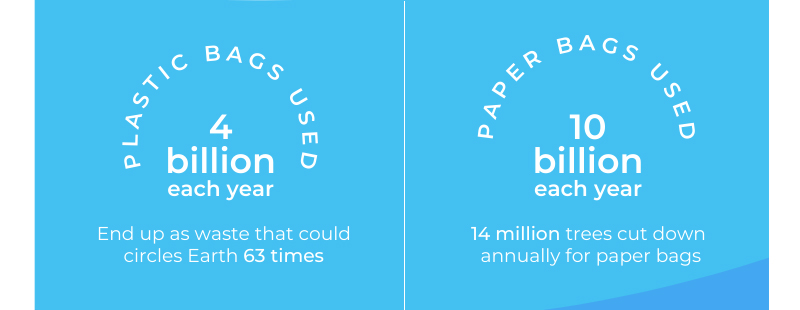
We can change the way we package our goods at the groceries, albeit certain levels of challenges towards the change.
The same could not be said with stretch films or paper films, which are hypercritical in protecting your goods, so they arrive undamaged.
Damaged goods mean unsaleable. That means embedded carbon footprints.
Therefore, minimising unsaleables is an essential factor in the sustainability equation.
2. Production
Production Process

Plastic is the bi-product of various fossil fuels or oil refining waste.
Plastic bags and films are made from plastic resin pellets.
The making of plastic bags begins with the formulation of resin pellets. They are melted according to a manufacturer’s formula to produce usable packaging for varying purposes.
Then, they are extruded into a thin tube of gradually cooling plastic.
Next, the printing of bags may are typically carried out at this point before cutting.
During cutting, a hot bar will drop a melting line on the tube at intervals for the predetermined desired sizes.
The final products are packed according to the customer’s needs before shipping.

Papers are made from trees, whether grown or found for the purpose of processing.
The trees are marked, felled and transported from the forest to the mill to be dried for at least three years before they are usable.
The barks are stripped. Then, chipped into 1” squares and cooked under tremendous heat and pressure.
They are then turned into pulp with limestone and sulfurous acid.
Next, the pulp is washed and bleached (requiring thousands of gallons of fresh water and bleach) and then pressed into the finished paper.
Finally, additional time, labour and energy are reserved for cutting, printing, packaging and shipping to make paper bags.
Note that in the above production resource comparisons, we did not consider the process of turning petroleum into resin pallets.
Energy Usage
According to a research paper, manufacturing a paper bag takes more than four times as much energy as manufacturing a plastic bag[5].
Plastic bags take about 594 BTUs versus 2,511 BTUs for paper bags to produce the same amount[6].
In other words, paper bags use 2.2 times the energy to produce 1,000 pieces as plastic bags, that’s 460 kWh vs 204 kWh, respectively[7].
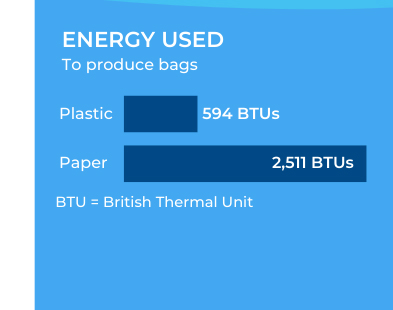
Water Usage
During the production, a large amount of water is used for processing the raw materials into finished products.
Producing 1,000 paper bags requires a little less than 4,000 litres, while plastic bag production needs about 250 litres. That means 16 times more than the amount used in producing plastic bags[8].
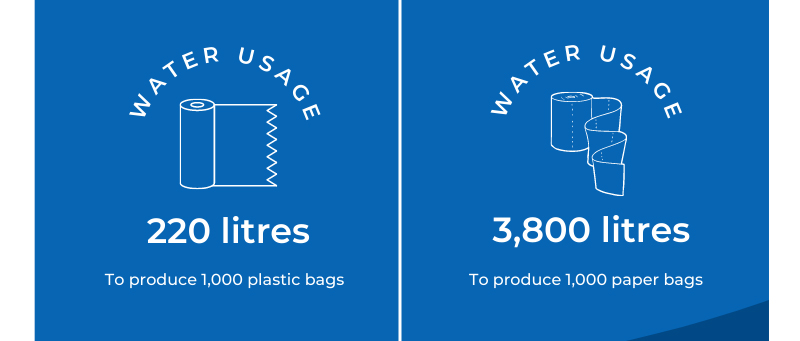
3. Functionalities
The usability of plastic is known to be higher than paper due to its water-resistant properties.
That coupled with its elasticity to hold more weight, plastic is an obvious choice for protecting goods.
That’s also why some paper packaging requires plastic lamination to compensate for its non-water resistant behaviour.
Particularly so on food packaging or liquid products packaging.
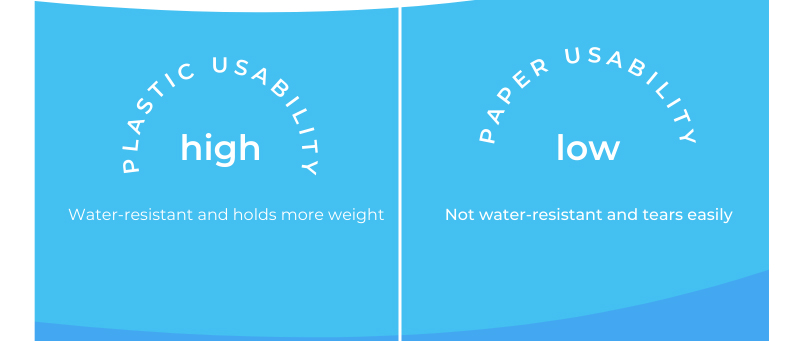
The elasticity and plasticity have made plastic the go-to materials for load securement.
However, in recent years, some brands have increasingly shifted focus to paper-based alternatives.
One case study by Lindum Packaging has resulted in high levels of product damage and food waste.
Two critical findings mentioned were
- the movement in transport issues of paper packaging and
- the effects of total packaging that comes with the switch (from plastic to paper).
That refers to embedded CO2 emissions.
Plastic packaging has been around for ages.
Decades of resources have been invested into refining, not just the products but how each level of packaging (primary, secondary and tertiary) affects the overall packaging.
Packaging optimisation can achieve higher load stability to reduce damage on arrival significantly.
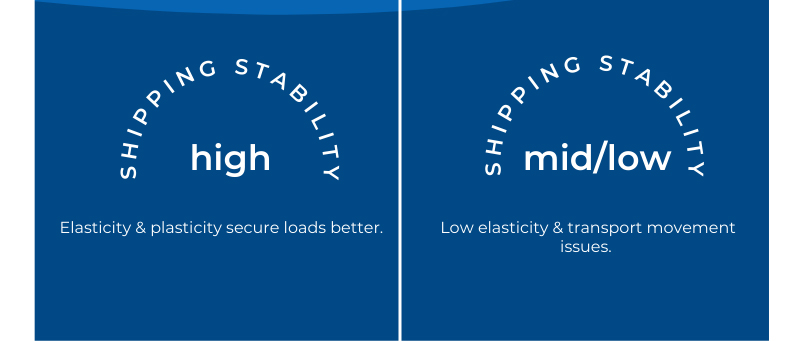
4. Pollution
Both materials have contributed to pollution, during production or at the end of their lifecycle.
Paper bag production contributes more than plastic bags—with about 70% more air and 50 times more water pollutants than plastic bag production[5].
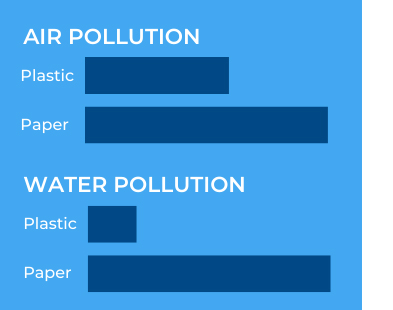
Paper bag causes higher pollution during production.
Air pollution, like acid rain, and water pollution are caused by the toxic chemicals used during the production of paper bags. In contrast, plastic bags create a more negative impact at the end of the plastic lifecycle.
Plastic production uses toxic chemicals too.
The plastics industry uses five of the top six commonly used toxic chemicals under an EPA ranking of chemicals that generate the most hazardous waste[9].
That is why we are managing our plastic waste at Thong Guan. Though nascent in making significant impacts, nevertheless, some changes are happening.
5. Recyclability
Paper has a higher recyclability rate but a limited recycling lifespan than plastic.
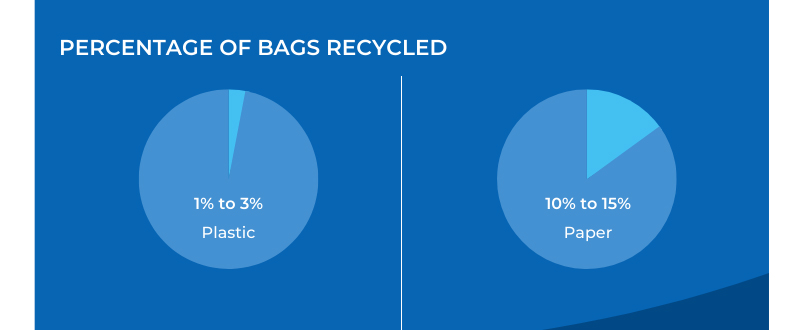
This is because paper fibre structure breaks after a few recycling cycles compared to plastics.
Moreover, after eight rounds of recycling the paper, it is homogenised and is no longer suitable for direct contact with food[7].
That is why every paper bag you use is mainly made from virgin pulp, as better strength and elasticity are required.
And paper bags are mostly recycled into corrugated cardboard.
To do so, they will need to return to a pulp using chemicals to bleach and disperse the fibres to recycle.
On the other hand, plastics will require remelting and reforming.
The caveat to plastic recycling is the resources needed for separating plastic types before recycling. And the quality of the plastic waste will affect the output of recycled resins.
The process itself is time-consuming and expensive. As such, more often than not, collected bags for recycling never get recycled.
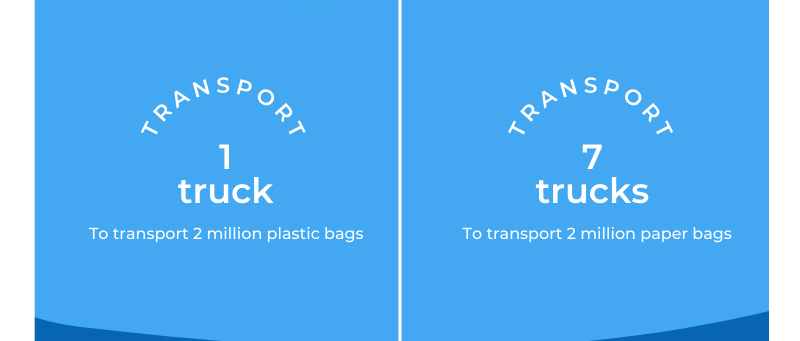
In the recycling process, transporting the same number of paper bags to a recycling facility requires seven times more trips than transporting plastic bags[3].
And the energy used for recycling a pound of plastic is 98% less than a pound of paper[3].

Thong Guan on recycling plastics
We are taking green responsibility as a plastic packaging manufacturer.
Today, we may be able to say no to the packaging of groceries, be it paper or plastics.
But they still play an essential role in palletising, particularly plastics, which have been the go-to packaging materials.
That is why, as a plastic packaging manufacturer, we know our role is vital in making changes or at least inspiring transformations among the players in our industry.
Some of our significant efforts include
- #LoopCloser™ Series. Our recycled plastic packaging products are achieved through in-house recycling, coupling with vigorous R&D formulation and testing, and countless simulation tests via Newton R&D lab to produce recycled-content products with retained quality performance.
- TG Nano Series. This product range significantly reduces the packaging weight through high-quality, high-performance, nano-layered films. Lighter packaging offers a significant opportunity to lower greenhouse gas emissions and pollutants and reduce materials going to landfills via damaged goods [10].
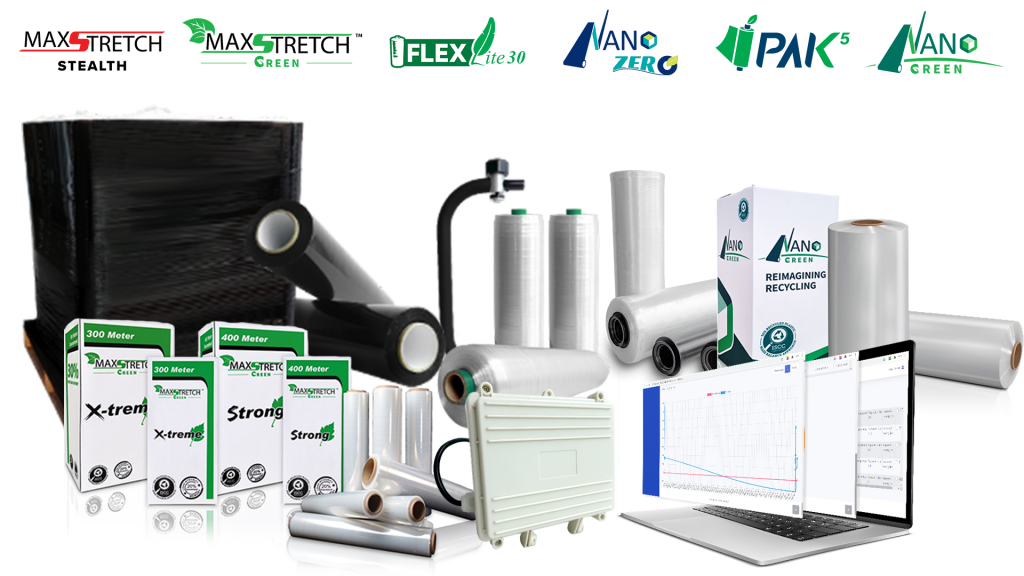
In Conclusion…
The way forward for the plastic packaging industry is to introduce better recycling systems so the circular economy can be sustainable. And engineer superior packaging products to reduce waste-to-landfills.
Drop us an email at info@thongguan.com to learn more about our recycling program RE:DO and RE:USE programmes, talk about #LoopClosers™ or waste-proof your packing for total savings via Newton R&D Lab.
Let’s work together towards a safer, better, and greener world.
References:
[1] Helmcke, S., Hundertmark, T., Musso, C., Ong, W., Oxgaard, J., & Wallach, J. (2022, July 26). Climate impact of plastics. Retrieved August 4, 2022, from https://www.mckinsey.com/industries/chemicals/our-insights/climate-impact-of-plastics
[2] Waste Management. Accessed 2021. Bags by the Numbers. http://www.wmnorthwest.com/guidelines/plasticvspaper.htm
[3] More Than Meets the Eye: Paper or Plastic? (2007, October 03). Retrieved August 1, 2022, from https://www.washingtonpost.com/wp-dyn/content/graphic/2007/10/03/GR2007100301385.html
[4] The main issues. (n.d.). Retrieved August 1, 2022, from https://sites.psu.edu/taxtheplastic/statistics-3/
[5] Bell, K., & Cave, S. (2011, February 23). Comparison of environmental impact of plastic, paper and cloth bags. Retrieved July 29, 2022, from http://www.niassembly.gov.uk/globalassets/documents/raise/publications/2011/environment/3611.pdf
[6] O., Prof. (2019, October 23). Life cycle analysis : Paper vs plastic bags – paper bags generate 70% moe air pollution and 50 times. Retrieved August 9, 2022, from https://www.studocu.com/en-us/document/san-jose-state-university/globalization-and-the-environment/life-cycle-analysis-paper-vs-plastic-bags/6998388
[7] Muthu S.S. et al. An exploratory comparative study on eco-impact of paper and plastic bags.
[8] Cherrier, H. (2006). Consumer identity and moral obligations in non‐plastic bag consumption: a dialectical perspective. International Journal of Consumer Studies, 30(5), 515-523.
[9] Groh, K., Backhaus, T., Carney-Almroth, B., Geueke, B., Inostroza, P., Lennquist, A., . . . Muncke, J. (2018, October 04). Overview of known plastic packaging-associated chemicals and their hazards. Retrieved August 2, 2022, from https://www.sciencedirect.com/science/article/pii/S0048969718338828
[10] R. Lilienfeld (Jan 2016). A Study of Packaging Efficiency as It Relates to Waste Prevention. Retrieved August 10, 2022, from https://eb430bb0-3787-4da6-85ea-30763d314d20.usrfiles.com/ugd/eb430b_f0445ac4479042f8b28b2d0f94dd8a6e.pdf
Other Sources:
Carbon Positive Australia; letstalkplastics.com; Packaging Europe; The Conversation; American Chemistry Council; American Forest & Paper Association; “Comparison of the Effects on the Environment of Polyethylene and Paper Carrier Bags,” Federal Office of the Environment, August 1988; Institute for Lifecycle Environmental Assessment; Paper Industry Association Council; “Resources and Environmental Profile Analysis of Polyethylene and Unbleached Paper Grocery Sacks,” Franklin Group, 1990; Reusablebags.com; Society of Plastics Industry; U.S. Environmental Protection Agency; Wordwatch Institute; The Washington Post; Sustainable Green Solutions Singapore;


